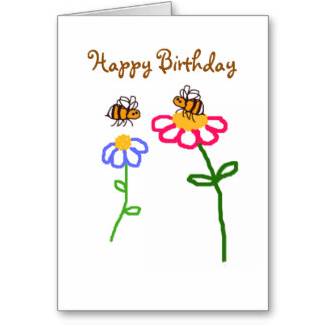Bees And Pollinators Visit Rosebay Willowherb - Chamaenerion angustifolium
Updated: 30th April 2021
As I write, it's April and young Rosebay willowherb plants are sprouting along the country lanes where I live, and in my garden. At the moment we're in lock down due to Covid-19, but fortunately we are allowed to go for walks, as long as we stay within our local neighbourhood, and observe social distancing guidance.
Seeing the young plants, I was reminded of photographs I took last year. Bees and other pollinators love Rosebay willowherb (Chamaenerion angustifolium), and although it's generally frowned upon by most gardeners, I have tended not to stress about it. Instead, it grows along a sunny wall behind the raspberries, and attracts different bee species and other pollinators. It is easily pulled out of the flower border if necessary.
(I should mention however, in some locations in the world, it may be considered invasive, so I'm not actively encouraging people to deliberately cultivate it).
Rosebay willowherb - popular with pollinators
Most of the photographs below were taken of plants on wild scrub land, and others on a rocky coast with limited soil. In fact, Rosebay willowherb is what is known as a 'pioneer plant' - one that can colonize areas where little else will grow. As the plant declines and its leaves, flowers and stems rot away, it eventually contributes nutrients to an otherwise barren piece of land, allowing seeds from other plants to take root and grow in the same location.
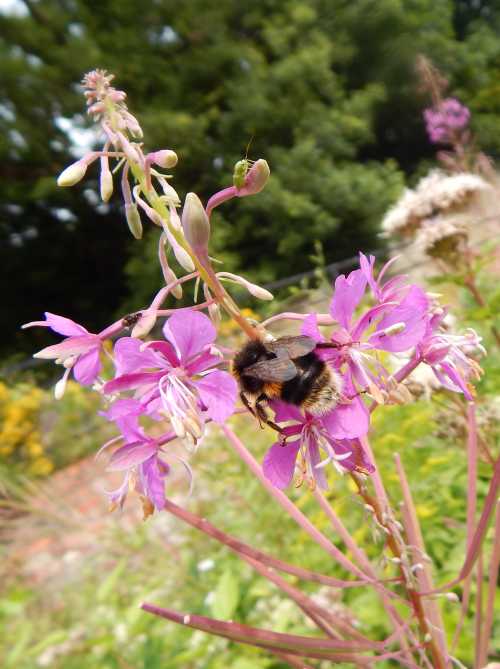 Rosebay willowherb is popular with bumble bees
Rosebay willowherb is popular with bumble bees
In North America, it is also sometimes called 'Fireweed', owing to the fact that it is one of the plants that will grow in soil that has been scorched by forest fires. In the UK, it is sometimes called 'Bombweed', thanks to its ability to colonize areas of London that had been damaged by bombing during the second world war.
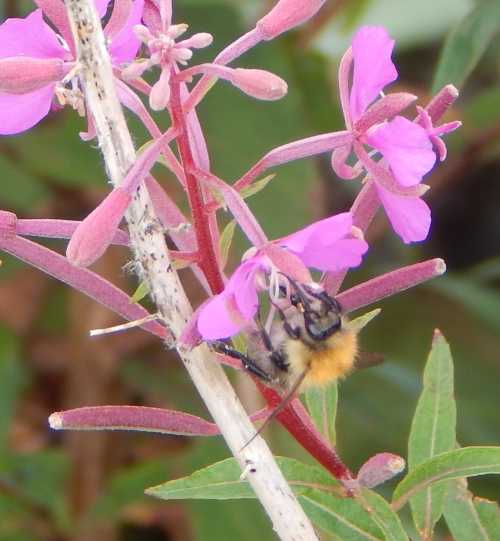 Common carder bumble bee foraging on Rosebay willowherb
Common carder bumble bee foraging on Rosebay willowherbHoney bees and bumble bees visit the flowers which offer both nectar and pollen. These tall wildflowers self-seed very easily and bloom late in the summer, when honey bee colonies have plenty of mouths to feed, and newly emerged bumble bee queens need nourishment in preparation for their winter snooze.
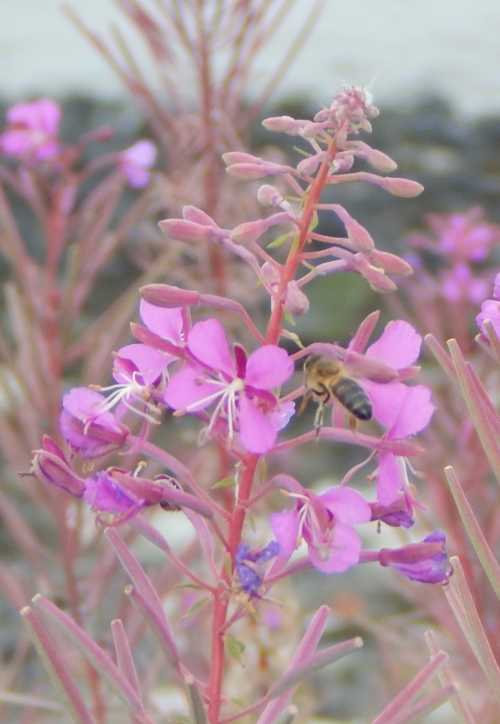 Honey bees also visit Rosebay willowherb
Honey bees also visit Rosebay willowherbInterestingly, Rosebay willowherb nectar is said to produce a distinctive honey (I have never tried it) if it is the primary source of nectar for the honey bees, although as a nectar plant, it cannot necessarily be relied upon by beekeepers for successive years.
It is also very attractive to the strikingly beautiful Burnet moth. In this coastal location where I took the photographs below, the Six-spot Burnet moth (Zygaena filipendulae) is commonly seen.
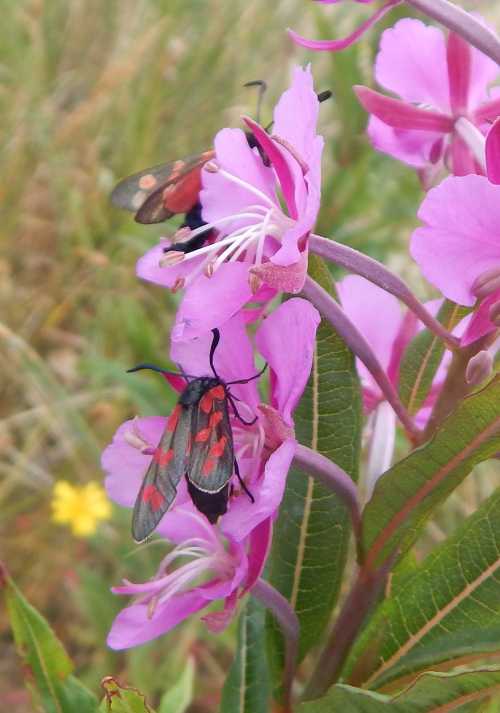 Six-spot Burnet moths on Rosebay willowherb
Six-spot Burnet moths on Rosebay willowherb
Other uses for Rosebay willowherb
Rosebay willowherb can be used to make tea. The young shoots can apparently be added to various culinary dishes, and the plant is sometimes used in various herbal remedies.
More wildflowers for bees
- Bees And Other Pollinators Love Dandelions - Birds Like Them Too! Why dandelions are beneficial for a wide range of pollinators, including bees, butterflies, and hover flies.
- Wildflowers for Bees And Pollinators: Thistles Bees love thistles, so if you want to photograph bees and pollinators, find a patch of thistles growing on a grassy verge or brownfield site on a sunny day.
- White Bryony Is Attractive To Bees The small whitish-green flowers of the wild vine, white bryony are attractive to bees, including honey bees, bumble bees and various solitary species.
- Wildflowers For Bees And Pollinators: Hemp Agrimony If I were asked to list my top wildflowers for bees and pollinators, hemp agrimony would be on my list. This pretty plant can also be grown in the garden.
- Cash Strapped Councils Could Save Money And Help Bees By Planting Clover Cash strapped councils could save money and help bees and pollinators by planting clover.
- Bees Love Green Alkanet - Pentaglottis sempervirens Bees Love Green Alkanet, a perennial wildflower related to borage and comfrey and with flowers resembling forget-me-not
- Knapweed Feeds Bees - Centaurea nigra Knapweed Feeds Bees: many bee species (and other pollinators) feed on this important wildflower seen in wildflower verges, grasslands and brownfield sites.
- Bird’s Foot Trefoil: Wildflower Beneficial For Bees Bird’s Foot Trefoil a wildflower beneficial for bees: a rich source of nectar and pollen for bees
If you found this page helpful or interesting, I'd really be grateful if you would share it with others - if not this page, perhaps another, such as Gardening For Bees.
Thank you so much :) .
